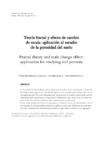Mostrar o rexistro simple do ítem
Teoría fractal y efecto de cambio de escala: aplicación al estudio de la porosidad del suelo
| dc.contributor.author | Vivas Miranda, J.G. | |
| dc.contributor.author | García Chomiczak, S. | |
| dc.contributor.author | Paz González, Antonio | |
| dc.date.accessioned | 2010-01-25T09:34:20Z | |
| dc.date.available | 2010-01-25T09:34:20Z | |
| dc.date.issued | 1999 | |
| dc.identifier.citation | Cadernos do Laboratorio Xeolóxico de Laxe, 1999, 24: 99-119 ISSN: 00213-4497 | es_ES |
| dc.identifier.issn | 0213-4497 | |
| dc.identifier.uri | http://hdl.handle.net/2183/6389 | |
| dc.description.abstract | [Abstract] In this article the fractal theory and its application to soil structure and porosity is rewieved.Fractal geometry may provide a reliable description of soil structure, particularly in the case of heterogeneous soil. The rewiev illustrates how the geometry of complex porous media may be represented with simple fractal scaling models. Furthermore, three main clases of models proposed in the literature for soil porous space representation are discussed. A case study was presented based on quantitative evaluation of pore size distributions carried on nine pairs of cultivated and uncultivated neighbour located soils. The fractal approach appears to be a useful tool for understanding domains of organization as found in soil aggregates. | |
| dc.language.iso | spa | es_ES |
| dc.publisher | Universidade da Coruña | es_ES |
| dc.title | Teoría fractal y efecto de cambio de escala: aplicación al estudio de la porosidad del suelo | es_ES |
| dc.title.alternative | Fractal theory and scale change effect: application for studying soil porosity | |
| dc.type | info:eu-repo/semantics/article | es_ES |
| dc.rights.access | info:eu-repo/semantics/openAccess |






